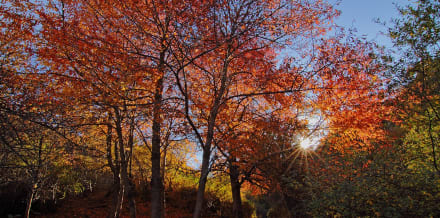More about: 10 Things to Do in Granada in Fall
I'm sure you can't wait to start your trip and discover all there is to see and do in Granada. No wonder! The Nasrid city is full of culture and in autumn it also enjoys an enviable climate, which makes it even more appealing to stroll through its streets, participate in the festivals of its most famous neighbourhoods or taste typical fruits of these months.
With the golden colour of the leaves of the trees, autumn landscapes arrive in Granada that I encourage you to get to know. The best thing is that this time of year is like an intermediate step between summer and winter, so you can either go down to the coast or up to the snowy mountains. How much do you want to go to Granada now? Take a pen and paper and write down all my recommendations.
1. Join Granada's most popular festivals in autumn

There are many ways to welcome autumn, but if you are in Granada you have to do it through the popular festivities of some of its most important and traditional neighbourhoods, such as the Albaicín.
September is the month in which these festivities take place, which usher in the new season and bid farewell to summer with music, dancing and lots of visitors. Are you going to miss them?
The Albaicín festivities
There is nothing like visiting Granada's Albaicín neighbourhood at the end of September, specifically on the 29th, when the San Miguel pilgrimage is celebrated. This is one of the original quarters of the city (it is located next to the Alhambra), so when you walk through it you will see how the Christian culture mixes with the city's Arab past.
What is the pilgrimage of San Miguel? In the past, the origin of the fiesta was in the Cerro del Aceituno; the local people would climb this hill and there they would organise craft markets and the young girls would wait with their mothers to be courted by the boys. Nowadays part of the tradition is maintained, although the festivities have been opened to the whole neighbourhood and even to the whole city of Granada.
The Zaidín festivities
Another place to enjoy the arrival of autumn is in Granada's Zaidín neighbourhood, although its history is more recent, as it began to be built in the 1950s.
Originally, the character of its festivities was more community-based, but nowadays it has a more vindictive objective: it aims to give visibility to the needs and projects being developed in the neighbourhood, such as dance groups.
As well as lots of flamenco, there is also plenty of rock, as the Zaidín organises a festival dedicated to this style of music. The concerts are outdoors, taking advantage of those last days of summer and first days of autumn that allow you to be (and dance) outside. The best thing?
Admission is free and it's an opportunity to discover new national and international groups.
Useful information
- When: during the month of September.
- Where: Albaicín and Zaidín neighbourhoods.
- Price: free.
- Recommended if: you want to join the locals in their celebrations.
2. Enjoy the best flamenco during the Autumn Festival in Granada

Granada is a very artistic city, something you will notice as soon as you arrive and see the number of flamenco clubs, theatres and museums. At the end of autumn in particular, an event takes place that highlights this: the Granada Autumn Festival.
Every year different shows are organised in various locations around the city, such as the Isabel la Católica Theatre. Tickets cost approximately 30€-40€ per event.
The Granada Autumn Festival is organised with the aim of showcasing the prestige and identity of the city through music, dance and the performing arts. As you can imagine, flamenco is the main protagonist, although there is also room for ballet and music of other styles.
If you feel like attending a concert by great flamenco singers, don't miss the chance. Of course, you can also go to one of the best flamenco tablaos in Granada.
Useful information
- When: late November and early December.
- Where: Isabel la Católica Theatre and other venues in Granada.
- Price: approximately 30€-40€.
- Recommended if: you like flamenco and the performing arts.
3. Come and see the offering of flowers at the Basílica de las Angustias
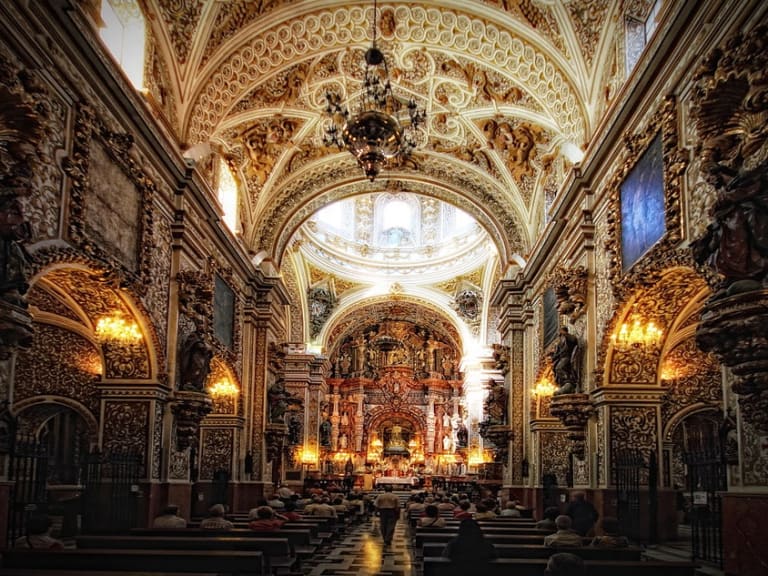
Are you planning a visit to the Basílica de las Angustias in Granada? If you go in autumn you will be lucky enough to see it as never before: full of flowers. Why? Because throughout the autumn months (especially in September) several floral offerings are organised to the Virgen de las Angustias, patron saint of the city. In total, thousands of flowers are placed here, giving a special light and colour to this 17th-century temple.
The good thing is that you will have several opportunities to see how the façade looks even more cheerful than usual. In addition, so many flowers that the surrounding area also has a good atmosphere, with stalls selling handicrafts and the famous Torta de la Virgen, a traditional sweet made from flour and usually filled with angel hair.
When you go to see the flowers in the Basílica de las Angustias, take the opportunity to visit it. Its interior was made by the best Castilian Baroque artists, so be prepared to see a lot of ornamentation and a large altarpiece presiding over the room.
Interesting facts
- When: Throughout the month of September.
- Where: Basílica de las Angustias.
- Price: free of charge.
- Recommended if: you plan to visit the Basilica and want to make it even more special.
4. Taste the best of Granada's produce at the "autumn fruits" market
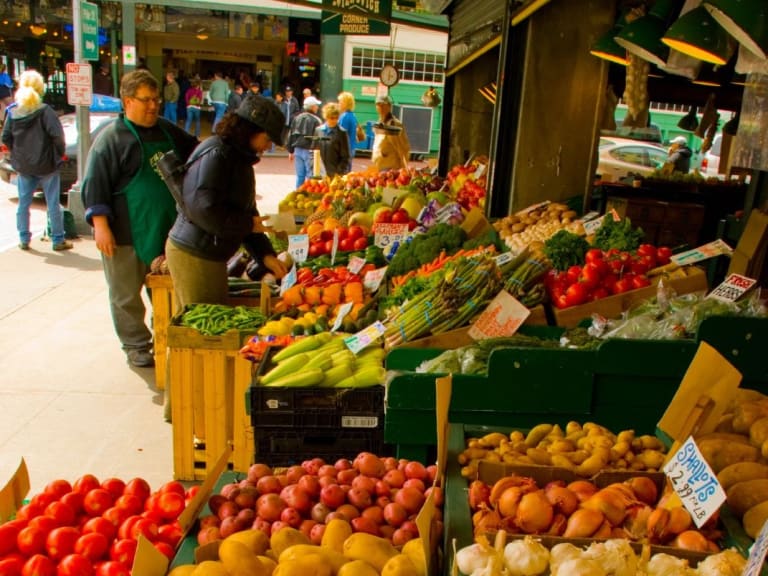
In Granada autumn smells and tastes of chestnuts, medlars, quinces, pomegranates... Where can you try them? In the area of Puerta Real and the Fuente de las Batallas, which are located in the Realejo neighbourhood (near the Cathedral) there are several stalls where local producers sell these delicacies that are only available during the autumn months.
Granada's autumn fruit fair is a unique opportunity to savour typical products of the city. I recommend you take advantage and buy some not only to try on the spot, but also to take home as souvenirs. My favourites are the acerolas, a fruit that grows in Central America but also in Granada and which look like cherries, although they are more acidic and have segments inside.
As you can see, in this market you can find fruit that you won't find in other parts of the country or even the world. As well as the flavours, I am sure you will be surprised by the smells, which you might not have known before.
Interesting facts
- When: from September.
- Where: Realejo neighbourhood (around the Puerta Real and Fuente de las Batallas areas).
- Price: free admission.
- Recommended if: you like trying new things, especially fruit and nuts.
5. Go to the concerts in the Generalife
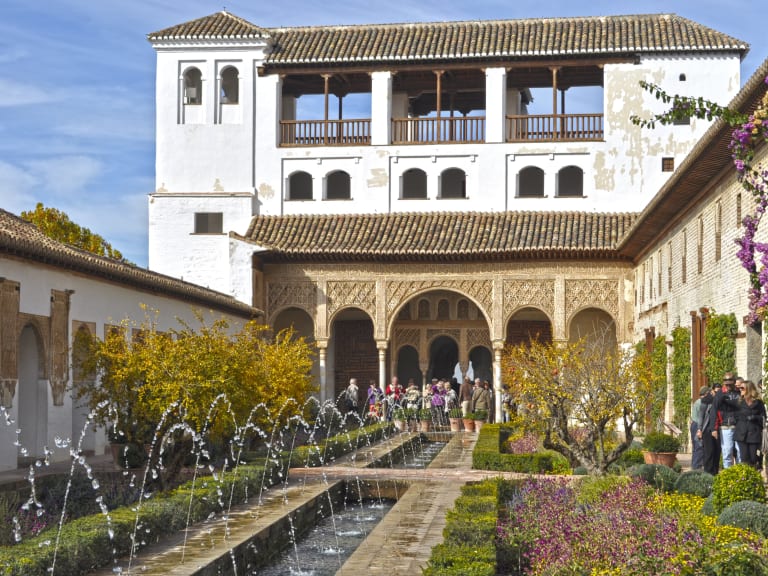
In autumn Granada hosts one of its most special musical events: September in the Generalife. This month-long series of concerts brings together national singers and groups, and the venue is the Generalife, the summer palace of the Alhambra. The ticket costs approximately 60€.
My advice is to buy a ticket for this festival and, after a guided tour of the Alhambra and a visit to the Generalife and its gardens, stay for one of the concerts.
It is an opportunity not only to listen to good music, but also to have the backdrop of the woods of the palace complex, which look even more impressive in autumn.
The September message in the Generalife is also very special. Since its foundation, the Alhambra has been linked to art and many musicians have performed there over the years. This festival aims to continue blending tradition and the avant-garde in this unique and historic setting.
Interesting facts
- When: during the month of September
- Where: The Generalife of the Alhambra.
- Price: approximately 60€.
- Recommended if: you like music and want to make the most of your visit to the Alhambra.
6. Feel the emotion of poetry at the Autumn in Verse festival

Do you like poetry? It could be said that Granada is a very poetic city; on the walls of the Alhambra, for example, there are beautiful verses written. Perhaps this is one of the reasons why the Autumn in Verse festival is held in autumn.
It is organised in the middle of autumn (between October and November) and consists of poetry readings and cultural events by young people from Granada. Admission is free.
Although at first glance the poetry reminds us of something "old", the Otoño en Verso festival in Granada gives it a modern twist. In fact, cockfights are organised between rappers and there is also space for other artistic compositions, such as circus, magic or dances.
The venues are distributed in theatres or cultural centres in Granada and nearby towns, such as Vegas de Gentil or Cúllar Vega, which are about an hour away from the capital.
Interesting facts
- When: October and November.
- Where: several theatres and cultural centres in Granada and nearby towns.
- Price: free admission.
- Recommended if: you like to keep up to date with new artistic proposals.
7. Dance and have fun at Granada Sound
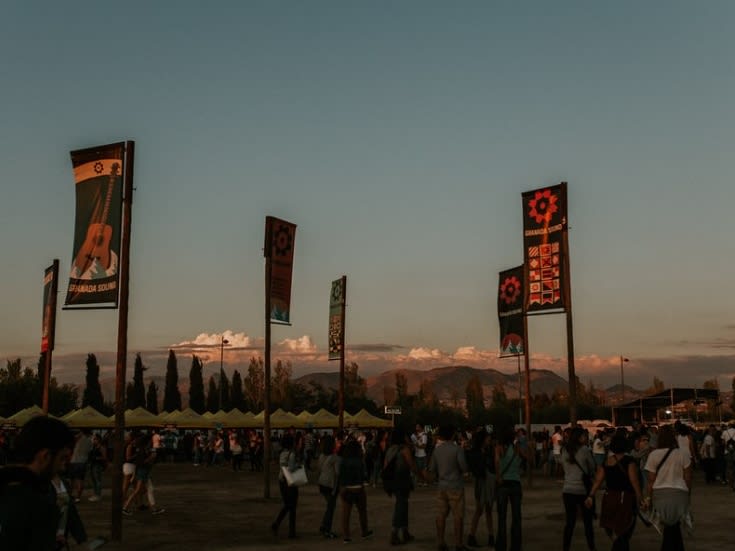
Who says that music festivals can only take place in summer? In Granada they know better, and that's why every autumn (one weekend in mid-September) they organise the Granada Sound. This festival brings the best indie music in Spain.
The entrance fee is approximately 50€ and, although it is held in the Paseo del Cortijo del Conde (on the outskirts of the city), it includes the shuttle bus to get there.
The Granada Sound was born several years ago and since then it has become a must for lovers of the most modern music. In addition, this event aims to give visibility not only to well-known groups, but also to emerging ones, so it is an opportunity to get to know new rhythms.
The best thing is that, in order to promote tourism within the city of Granada, other concerts are organised within the city and they are free! You can also join routes around the places in Granada that are important in the world of music.
Interesting facts
- When: mid-September.
- Where: the main event is in Paseo del Cortijo del Conde, but there are secondary locations around the city of Granada.
- Price: approximately 55€.
- Recommended if: even on your travels you can't get enough of discovering new music.
8. Get to know the Alpujarra with a hiking route in autumn
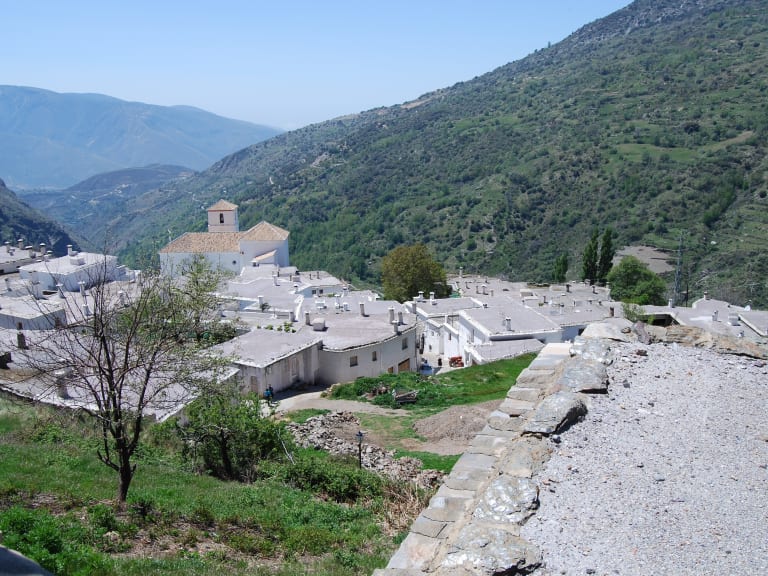
I would dare to say that autumn is the best season to go hiking in the Alpujarra; when you try it, I'm sure you'll agree with me. The Alpujarra is a region of Andalusia very close to Granada; there are traditional villages and also a great number of itineraries for all levels. It's quite easy to get there (less than two hours) and the scenery is well worth the effort.
A trip from Granada to the Alpujarra is a great way to enjoy your autumn trip without being too hot or too cold. During the tour you can combine a guided tour through traditional villages with a hike in the mountains. There are plenty to choose from, but I would like to recommend some of my favourites:
- Barranco de Poqueira: perhaps not the easiest (it has a drop of more than 600 metres), but it goes through the three most famous white villages in the area (such as Pampaneira, Capileira and Bubión), where you can taste Arabic gastronomy and learn about the art of carpet weaving.
- Sendero de las Acequias: this is a more accessible route, as it runs through the shade. It also passes through places of great beauty (especially in autumn when the fruit comes out of the trees) and of great historical value.
- Sendero de las Encinas: it is only 5 kilometres long, so I recommend it if you don't have much time or if you don't usually go hiking. The most notable thing is that it passes along the Camino Real, which used to link Granada with Almería.
Interesting facts
- When: throughout the autumn.
- Where: the Alpujarra.
- Price: free.
- Recommended if: you like hiking and want to get to know the villages of Granada.
9. Walk through the historic centre of Granada while eating roasted chestnuts, typical of autumn
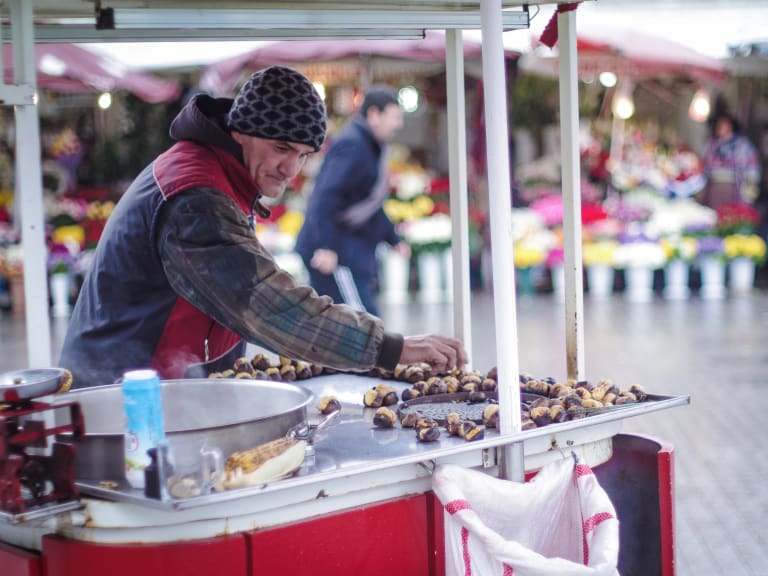
One of the best tours of Granada is through its historic centre. The good thing is that in autumn the chestnut stalls, which have been harvested directly from the Alpujarra, start to appear on the streets. The smell of chestnuts permeates every corner, so you'll find it hard to resist tasting them.
From the end of October onwards (although sometimes earlier) the centre of Granada fills up with chestnut stalls. As there are many chestnut trees in the Alpujarra area, this fruit has become a staple of the local cuisine. In fact, it is possible that some restaurants in the city serve a special dish, such as chestnut stew.
In any case, I recommend you buy a cone (it costs about 2€ for half a dozen) and eat the chestnuts as you stroll through the old town of Granada. They will warm your hands (and your stomach) while you discover emblematic places such as the Cathedral of Granada, the Royal Chapel or the narrow streets of the Alcaicería.
Interesting facts
- When: throughout the autumn.
- Where: historic centre of Granada.
- Price: approximately €2.
- Recommended if: you want to make your walk through the old town of Granada more special and tasty.
10. Make the most of the last days at the beach on the Costa Tropical

Who says you can't go to the beach in autumn? Especially during the month of September (and even at the beginning of October) you can take advantage of the last days of sunshine to take a day trip to the Costa Tropical.
There you will find towns like Salobreña or Almuñécar which, about 1 hour from Granada, stretch out the summer so that you can swim in their turquoise beaches.
In fact, it could even be said that in autumn they are much more enjoyable, as there are fewer people, but the Mediterranean Sea still creates a perfect climate for a day of sunbathing and a dip in water that is warmer than in early summer.
The reason for this is that all these villages are protected from the wind by the mountains and are close to North Africa.
Besides going to the beach, you can take the opportunity to get to know these places. For example, in Salobreña, a town that you can reach by car on the A-44 in just 45 minutes or by bus, there is a famous medieval castle. Almuñécar, although its beaches are made of stone, is also very close and in autumn there is also a jazz festival.
Interesting facts
- When: all autumn.
- Where: Costa Tropical.
- Price: free.
- Recommended if: you like to go to the beach and extend your summer.
Granada's temperatures in autumn
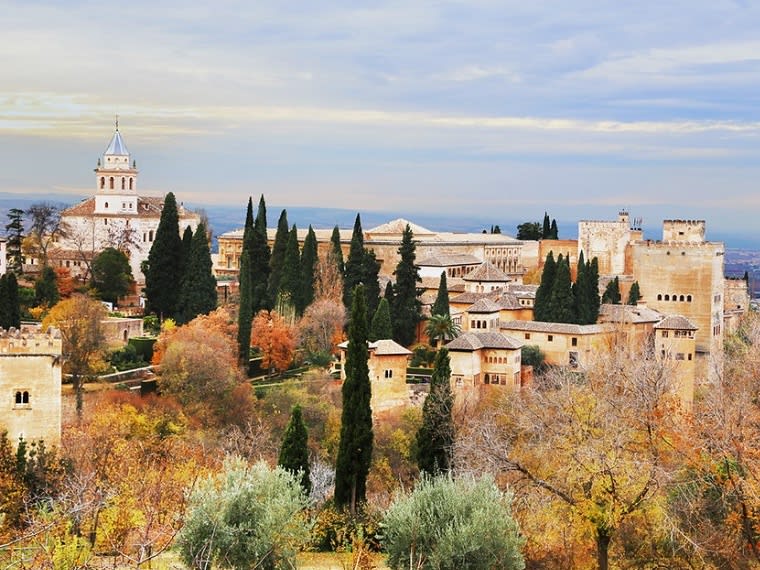
The best thing about going to Granada in autumn is that you will be able to enjoy very good weather, with temperatures between 25ºC and 10ºC (although these drop to a minimum of 5ºC in November), without the oppressive heat of summer in Granada.
Rainfall is more likely, especially towards the end of the season, although if it does rain it is usually light.
What you should bear in mind when packing your suitcase is that temperatures are at their highest during the day (over 20ºC), but it will cool down at night, so a jacket will come in handy.
Tourism in Granada during autumn
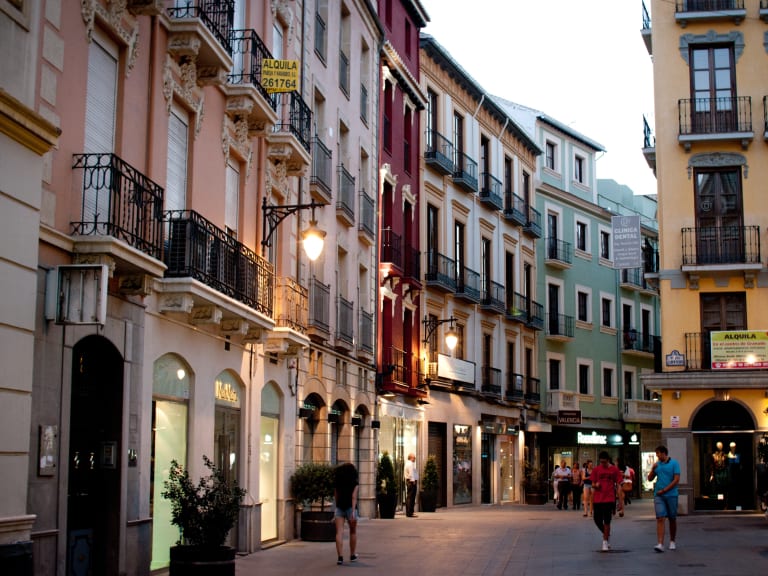
Although Granada's autumn temperatures, especially at the beginning, are somewhat reminiscent of late summer, tourist crowds do drop. Generally, there are not many less visitors during these months, so you can take advantage of the low season to find cheaper hotels.
Be careful, even if there are fewer people, the Alhambra is always of great interest, so it is always advisable to book your tickets in advance. This way you can make sure you can go on the day you want and at the time you want.
Are you all ready to travel to Granada in autumn? I hope these plans will help you enjoy your visit even more.
